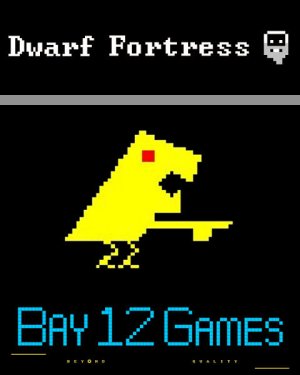Slaves to Armok II: Dwarf Fortress is an 2-in-1 interconnected ASCII based game currently still in its alpha stage (under development). Additional gameplay features may be introduced with each new version. Although the default graphic display is in ASCII, a limited 2D graphical display is also officially supported, however the game configuration must be tweaked manually by the player for it to become available. Fan-made graphic sets and other features can be downloaded separately to change the default features, in addition to personal modding.
Dwarf Fortress
The first and primary mode of the game is the Dwarf Fortress mode, a city building simulator. Before actual gameplay, the player must first create a random world, pick a location for a starting outpost, stock up the seven strong dwarven team for the hard seasons ahead, embark, and find a suitable location on the world map.
City building, depending on player creativity, offers numerous possibilities. The basic strategy is to dig into a mountain or dig underground. Rooms may later be used for specific purposes, such as building forges, farms, sleeping quarters, improving the initial outpost and creating wealth. The first few seasons usually focus on a self-sufficient food supply, creating initial rooms, creating an economy that manufactures basic goods (furniture, crafts, clothing, etc.), and later selling those goods to (if available), human, elven, and dwarven caravans. All this while also trying to maintain food and alcohol stocks for your dwarven workers, managing population happiness, architectural planning, and defending the outpost from possible attacks. After the outpost achieves a basic level of functionality and security, the player may then have to focus on a more elaborate military infrastructure (traps, drawbridges, armor, weapons, soldiers) for defense against kobold thieves, goblin kidnappers, braving dangerous animals, fighting off besieging forces and megabeasts and exploring unsafe caverns.
Each dwarf has a set of skills, indicating the level of expertise the dwarf has. A master miner for example will mine much faster than a novice miner, the same goes for military units. Continued use of a particular skill will increase a dwarfs’ skills from the lowest dabbling skill to the highest legendary skill. Skills are also related to the many jobs available to maintain a dwarven industry, such as jewelers, smiths, masons, etc. Items manufactured may be individually used by the dwarves, incorporated into the city, or traded off to other civilizations.
Losing the fortress to the numerous challenges however, does not end the game. The player may then choose to send in another party to reclaim the ruins, return as a single adventurer, or simply start fresh in another location.
Adventure Mode
The role playing version of the game may also only be played after a world has been created. The player can choose a human, dwarven or elven character, personalize available skills and set forth into the wilds. Events that have occurred during Dwarf Fortress mode are recorded, thus the player may visit the previous fortress (what’s left of it) and obtain previously manufactured items.
Default gameplay consists of completing quests given by NPCs (Non-Player Characters), usually revolving around killing certain powerful monsters. In doing so, the player may find or buy and sell items, weapons, and armor to equip the player.




